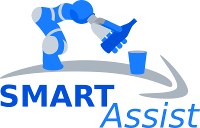SMART-Assist

The SMART-Assist project is designing an assistive robotics system for people with severe motor impairments. The project is setting up a functional demonstrator called EDAN (EMG-controlled Daily Assistant) based on the DLR lightweight robot and a conventional electric wheelchair. The focus of the research is on controls based on electromyography (EMG), which makes the system accessible to people who are unable to operate a joystick. Moreover, semi-autonomous capabilities are being developed for EDAN, which enable the user to perform habitual daily activities like pouring and drinking a glass of water. The research results are tested and evaluated in close cooperation with affected subjects in order to align our research in a targeted manner.
Duration: | 2016-04-01 until 2018-02-28 |
Project partners: | |
Website: | |
Applications: |
|
Project details
Demographic change in Germany is facing the healthcare and nursing system with major challenges. The rise in life expectancy also increases the risk of age-related diseases like stroke. Approximately 20–25% of stroke patients still suffer from significant motor impairments after rehabilitation. These motor impairments range from impairments in walking and sitting to one-sided or total paralysis. If the disability is restricted to the legs, a highly sophisticated tool is available to many affected people with modern electric wheelchairs. However, if the paralysis affects the upper limbs, leading a self-determined life in one’s own home is nearly impossible. Accidents or other diseases, such as amyotrophic lateral sclerosis (ALS) or spinal muscular atrophy (SMA), can also cause such severe motor impairments. Affected individuals cannot carry out even the simplest daily activities such as eating or drinking without the help of others, and are therefore dependent on intensive 24-hour nursing care.
Assistive robotic systems can be of great help to these people. Innovative torque-controlled lightweight robots and the related concept of soft robotics are making safe direct human-robot interaction possible for the first time. Attached to a wheelchair, such a lightweight robot arm can significantly increase the mobility and independence of these persons. Even if the use of electric wheelchairs gives many paralyzed people mobility, their own front door or elevators are often insurmountable obstacles for them. Small things that are a matter of course for healthy people, such as drinking a sip of water, cannot be done without the help of someone else, but they can be managed with the help of a wheelchair-mounted robot arm.
The first systems on the market are controlled by means of a joystick and grasp objects via an integrated gripper. These systems allow people with minor motor impairments of the upper extremities to carry out simple tasks of daily life autonomously, thus at the very least temporarily regaining independence.
While systems of this kind offer a great deal of help to many people, there is still a potential for improvement in their operation and deployability. For example, many people with disabilities of the upper limbs are not able to operate a joystick needed to control them.
At the DLR Institute of Robotics and Mechatronics, therefore, research has been carried out for quite awhile on interfaces for the control of such assistive systems. A pilot study has shown that the remaining muscles of people with SMA continue to produce measurable electromyography (EMG) signals. Using these signals, two subjects paralyzed by SMA were able to remotely control a robot arm and thus grasp objects and put them back down again. However, in order to perform more complex tasks safely, such as pouring water, it is necessary to support the user by means of semi-automatic robotic capabilities. The idea is to map the measured EMG signals to the task rather than to the movement of the robot. For this, the robot uses its knowledge of the world to predict the intention of the user and to carry out the task accordingly. Simplified in this example, the robot automatically executes the motions required for pouring when the user moves a water bottle close to an empty glass. This principle can be used for many everyday tasks such as opening doors and drawers or pressing buttons.
This technology will be developed and demonstrated in the SMART-Assist project using a robot arm mounted on a wheelchair. The development of SMART-Assist considerably simplifies the use of assistive robotic arms or makes it at all possible for many people with severe disabilities.
